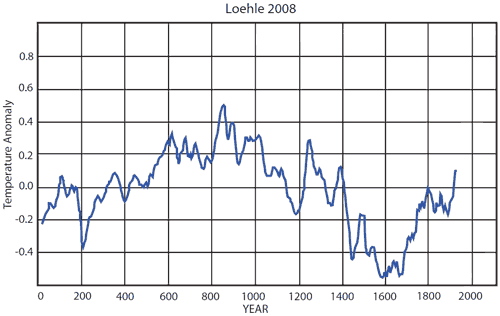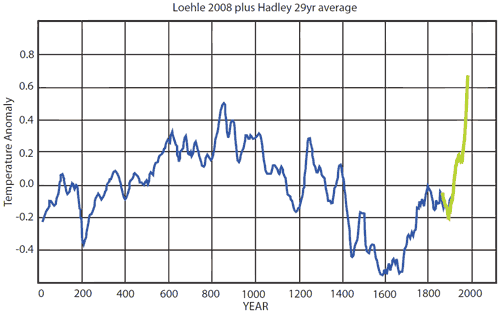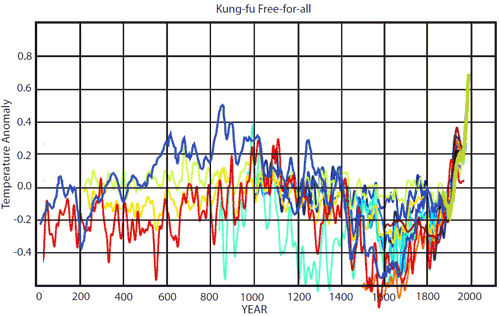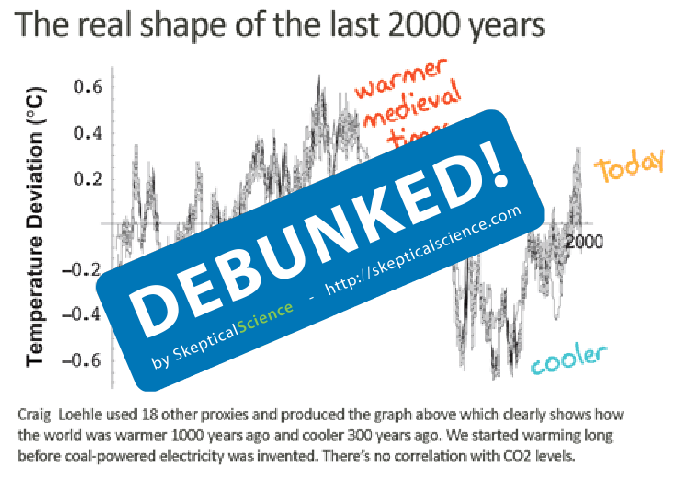Kung-fu Climate
Posted on 6 May 2010 by Rob Honeycutt
Guest post by Rob Honeycutt
The other day I happened upon the Popular Technology blog that has a list of "700 peer reviewed papers supporting skepticism of man-made global warming." This was news to me so I started to look into the first paper on the list. Loehle 2007 titled A 2000-Year Global Temperature Reconstruction Based on Non-Treering Proxies published in Energy & Environment. I'm sure many Skeptical Science readers are familiar with this paper and Loehle's 2008 correction. I was not.
I decided to email Dr. Loehle with some questions and got a very prompt response from him. This was followed by a number of back and forth emails. What I got from him was that he believes himself to be one of the scientists whose work is blocked from publication for political reasons. And I got that his motivation for this 2007/2008 paper was to point out the "politically motivated" science trying to obscure the MWP by Michael Mann and others. I do not doubt Loehle is genuine in this statement and that he is genuine in his desire to do good science. Nor do I doubt that Mann, Briffa, Moberg and other who have done similar temperature reconstruction to be any less genuine in their desire to do good science. I have no reason to doubt either. But as I put it to Loehle, "I think contentious issues in science have always been a bare knuckle brawl." This is not new to climate science. Often it comes down to whether my kung-fu is better than your kung-fu.
So, in this kung-fu match, not being a scientist myself, I have to place myself in the position of the audience watching the fight. I'm not a kung-fu master. I'm a spectator trying to decide whose kung-fu is better. I've read all the arguments against Loehle's 2008 paper with regards to it having far fewer (only 18) data sets opposed to Mann's 1200 data sets. But that's fine. I accept that Loehle is trying to tease out potential errors imposed from treering data.
As I was researching this I came onto one post on Yahoo Answers from a person called Keith P who tries to answer the question, "Does Loehle actually refute Mann in any way?" Keith does something quite simple that I have reconstructed for myself. He just scales Loehle's to the "hockey team" chart that contains Mann, Briffa, Moberg and other temperature reconstructions and overlays the two. The result, to me, was very illuminating but I'm going to take a slightly different approach than Keith P.

Figure 1: Loehle 2008 temperature reconstruction.
In Fig 1, I have taken Loehle's temperature anomalies and kept his scale in both the X and Y axis. I've also kept his zero axis. I believe this is a reasonably faithful reconstruction of Loehle's data. My apologies to the data purists out there who might find some inherent abomination in my method. Graphically it works (I don't know why more scientists don't either enlist the help of a graphic artist or at very least audit a couple of courses at their local university).
The other critique of Loehle's paper has been that the data ends in 1935. This, from my position in the bleachers of the kung-fu match, is much more problematic for Loehle. I know the paper is not about current warming. I know it's about treering proxy errors but that is sort of missing the forest for the trees (pun is definitely intended). I understand why the data ends at 1935. But I just can't buy NOT making the attempt to concatenate this data with the past 150 year of recorded temperature readings. Even if the modern temperature records are not central to the topic of the paper to not add the blade to his hockey stick is a mistake. Maybe not from a scientific perspective, but from the bleacher's perspective it is.

Figure 2: Loehle 2008 temperature reconstruction with Hadley instrumental record.
While I was writing this Loehle was kind enough to provide me with a Hadley chart with the same 29 year smoothed average as his data allowing me to compare apples to apples. In Fig. 2 I have added the Hadley data to his. It takes quite a bit of scrunching (my technical term) to fit 150 years of data into a 2000 year chart. This is definitely a rough cut and paste so I would not be prepared to make any claims about precisely how many degrees warmer today is over the MWP based on this chart. One should note that since this is a 29 year smoothed average not all the most recent (less statistically significant) data is included. The only conclusions I can come to is that the current warming has happened as fast or faster, and is more sustained, than any time in the past 2000 years, and that we are at least as warm as the MWP and maybe warmer. I would not assume Loehle's work to be definitive here any more than I would consider Mann's to be so. No, it's not a scientific conclusion. It's a conclusion that the rest of the 99.9999% of the non-scientific world has to try to grapple with.
In the final battle in this kung-fu match I have to throw everyone into the ring together. Mann with his Crouching Tiger style. Crowley and Lowery with their Striking Serpent. Jones and his Monkey Fist style. Moberg is a student of Jackie Chan's Drunken Boxing. Briffa's Shaolin and his et al grasshoppers. And all the others pasted in behind Loehle's Wing Chung style chart. This is Fig 3.

Figure 3: Loehle 2008 temperature reconstruction (blue) with other temperature reconstructions (source: Wikipedia).
What a bizarre, almost absurd, cacophony. What I see in this is a battle of home made hockey sticks. Some straight, some crooked, some short, some long. But I see all our kung-fu masters each beating the other with their own hockey sticks. What's most strange to me is that it seems like the MWP battles are all about the shape of their hockey sticks and miss the rather more important question of NOW. I have two kids that are 5 and 6. When they are in their 20's or 30's I'm going to have to answer to them and tell them what I did back in 2010. What did I know and what did I do about it? Now really is everything.
There is a wide gap between you kung-fu masters in the ring as you bloody each other up over these kinds of issues and those of us in the bleachers trying to understand what this fight means. It's certainly easy to sell tickets to this bloody brawl but don't forget that the rest of the world needs to potentially make some very quick decisions with regards to the future of our planet. This is not a political statement, this is just a potential statement of fact. I urge everyone in science to stop playing games. Fight the good fight. Pay respect to a good fighter. And may the best kung-fu win.
I want to extend my personal thanks to Dr. Loehle for his patience in answering my rather long string of questions.
































 Arguments
Arguments























 0
0  0
0 Note that the HadCRU record, which you apparently don't trust, is essentially identical to the open-source one from GISS, and the one from NCDC, and the ones from independent bloggers (Zeke and Nick). And again, you can download and test out the code yourself for many of these analyses (GISS, Clear Climate Code, Nick Stokes's TempLS code, etc.)
Of course, if for some reason you don't trust any of those people, and you're not up for actually reading their code or writing your own, you could ignore the land surface temperature record entirely, and just consider sea surface temperature trends, which presumably don't have any Urban Heat Island effects. Kelly O'Day has a nice set of R scripts for downloading and processing climate data, including one for the long-term global SST trend, which -- surprise! -- also shows increasing temperatures:
Note that the HadCRU record, which you apparently don't trust, is essentially identical to the open-source one from GISS, and the one from NCDC, and the ones from independent bloggers (Zeke and Nick). And again, you can download and test out the code yourself for many of these analyses (GISS, Clear Climate Code, Nick Stokes's TempLS code, etc.)
Of course, if for some reason you don't trust any of those people, and you're not up for actually reading their code or writing your own, you could ignore the land surface temperature record entirely, and just consider sea surface temperature trends, which presumably don't have any Urban Heat Island effects. Kelly O'Day has a nice set of R scripts for downloading and processing climate data, including one for the long-term global SST trend, which -- surprise! -- also shows increasing temperatures:
 .
Then again, if you don't trust sea surface temperatures, you could look at satellite measurements of temperatures in the lower troposphere, which also show an increase over the past three decades. (UAH's analysis has a slightly lower trend, but RSS's trend is a very close match for all the land surface temperature trend analyses).
Or, you could ignore all of that, and just assume that the climate science community doesn't make any of its data or software available so it's all a big hoax.
.
Then again, if you don't trust sea surface temperatures, you could look at satellite measurements of temperatures in the lower troposphere, which also show an increase over the past three decades. (UAH's analysis has a slightly lower trend, but RSS's trend is a very close match for all the land surface temperature trend analyses).
Or, you could ignore all of that, and just assume that the climate science community doesn't make any of its data or software available so it's all a big hoax.







Comments